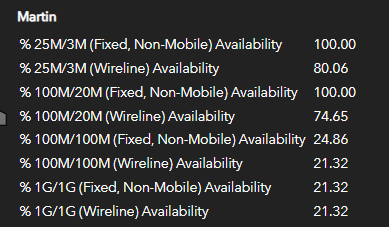Martin County
| Year | Rank | 100/20 Mbps |
|---|---|---|
| 2024 | #70 of 87 | 74.65% |
| 2023 | #69 of 87 | 72.6% |
| 2022 | #71 of 87 | 67.03% |
| 2021 | #68 of 87 | 66.71% |
| 2020 | #62 of 87 | 68.24% |
| 2019 | #64 of 87 | 55.22% |
| 2018 | #48 of 87 | 54.8% |
| 2017 | #39 of 87 | 54.06% |

Red dots represent unserved locations.

Wired (wireline) and wireless (fixed, non-mobile) served location percentage at various speeds.
Martin County: Hoping New Engagement Spurs Investment
Martin County ranks 70 (down one place) for broadband access out of 87 counties.
They have 72.6 percent coverage to broadband of 100 Mbps down and 20 up. They have 2398 households without access to broadband at that speed. Estimates indicate that it will cost $22.3 million to get to ubiquitous broadband in the county.
Martin County hovered around 67 percent coverage to broadband, last year they had a big jump and this year, an incremental increase. They have an $8 million grant next year, which should help them get even closer to goal.
One side fact: They may be concerned about being in a potentially precarious position because looking at access in the County using the FCC National Map there is a big discrepancy between wireline access and wireline with fixed wireless. Minnesota doesn’t currently take fixed wireless into consideration when defining areas eligible for grants; the federal government does include access to fixed wireless. That could make a big difference to who is eligible for BEAD funding.
- Over the years, Martin County (or cities within) has invested $805,842 (total) for matches for 1 successful MN Broadband grants This is an indicator of local government that is engaged and (literally) invested in better, local broadband.
- Martin County will benefit from a 2024 $8 million MN Broadband grant (Round 10) award that will serve 457 locations.
- Martin County will benefit from 4 line extension awards (Rounds 1 and 2), which extend broadband to individual locations.
- Last years’ estimates indicated that it would cost $22.3 million to get ubiquitous broadband in the county. (I haven’t updated the number because recent report offers scenarios of costs based on BEAD funding rules that make current estimates less predictable than in the past. Yet, I think the number is still helpful.)
- In 2022, Martin ranked 61using Microsoft’s Digital Equity Tool, which looks at various factors of a community.
Household Density
12.0
Number of Providers
20
As of 2023 · Source: MN DEED
Households with Device Access
statewide
statewide
statewide
statewide
statewide
Has Worked with Blandin Foundation
Yes
Martin County has worked with the Blandin Foundation.
Has Received MN Grant(s)
Yes
2016 – GRANADA TELEPHONE COMPANY (DBA BEVCOMM) SOUTH RURAL GRANADA – GRANT: $157,920
2016 – MARTIN COUNTY (WITH FRONTIER) RURAL BROADBAND INITIATIVE – GRANT: $1,677,823
2017- BEVCOMM (Granada Telephone Company) — Granada Rural Final – GRANT: $202,410
BEVCOMM (Blue Earth Valley Telephone Company & Easton Telephone Company) – Rural Faribault County Project – GRANT: $579,781
There is a matrix of Minnesota broadband adoption projects.
MN State Grant awarded in 2021: BEVCOMM (Blue Earth Valley Telephone Company, Easton Telephone Company & Cannon Valley Telecom) – Rural Faribault County and Martin County Fiber Expansion Phase 2 Project – GRANT $1,182,818 This last mile project will serve approximately two unserved households, 203 underserved households, 46 underserved businesses, and 181 underserved farms in portions of Faribault and Martin counties.
2022 – Bevcomm – Rural Faribault and Martin Counties Fiber Expansion Project – Phase Three – GRANT $1,444,030 (serving Faribault and Martin Counties)
2024:
- County: Martin
Federated Rural Electric Association Martin County Low Density
Grant: $8,008,419
Local Match: $2,669,473
Total Budget: $10,677,892
This Low Density Federated Rural Electric Association in Martin County will see Fiber to the Premise (FTTP) Network to be built in rural Martin County. The project will enhance the quality of life and foster community growth for businesses, farmers, and residents at 457 locations, including 431 unserved and 26 underserved addresses. Funding partners include contributions from Martin County, Lake Belt Township, Rolling Green Township, for a total partner contribution of $800,842.
Government Districts
U.S. Congress: CD 1
MN Senate: 21, 22
MN House: 21B, 22A